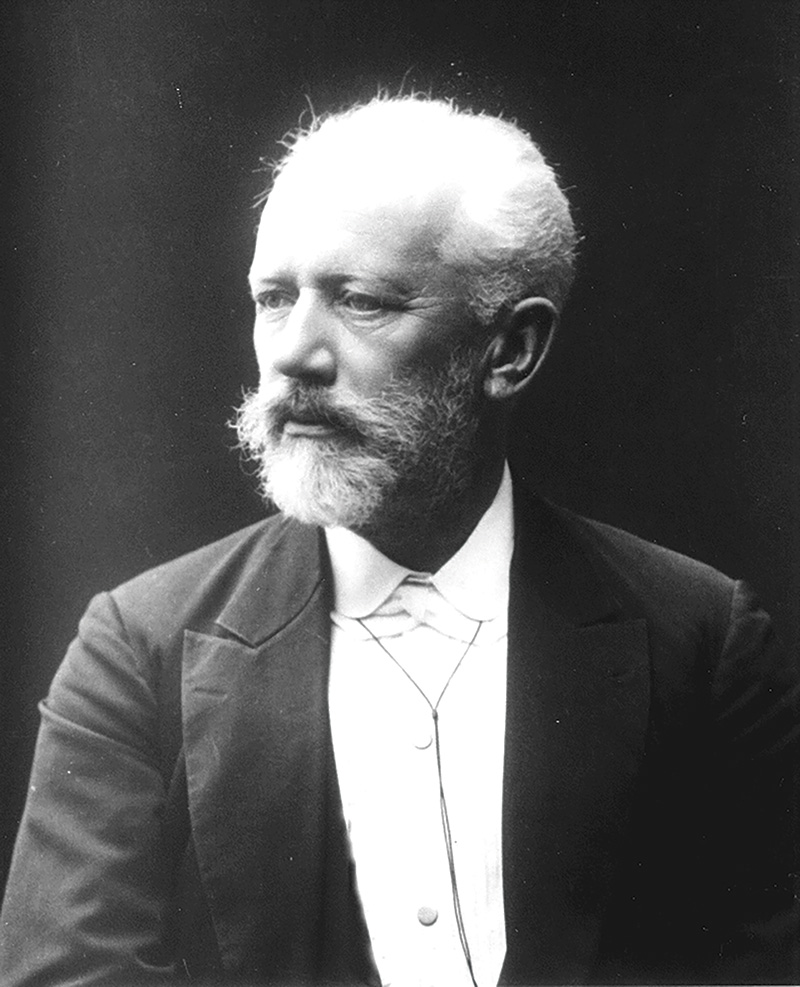Piotr Ilyich Tchaikovsky

- Born: May 7, 1840, Votkinsk, Russia
- Died: November 6, 1893, St. Petersburg
Symphony No. 5 in E Minor, Op. 64
- Composed: 1888
- Premiere: November 1888, St. Petersburg, Russia at the Mariinsky Theatre with the composer as conductor
- Instrumentation: 3 flutes (incl. piccolo), 2 oboes, 2 clarinets, 2 bassoons, 4 horns, 2 trumpets, 3 trombones, tuba, timpani, strings
- CSO notable performances: First: April 1896, Frank Van der Stucken conducting. Most Recent: 2017 European Tour, Louis Langrée conducting. Most Recent Subscription: November 2014, Louis Langrée conducting. Other: Conducted by every CSO Music Director.
- Duration: approx. 50 minutes
Despite his growing international fame, Tchaikovsky was constantly plagued by self-doubt. Early in 1888, he went on a three-month European tour, conducting his own works with some of the world's finest orchestras. He was lionized in Leipzig, Paris, London and Prague, and he met Dvořák, Grieg and Mahler. Yet his private life was not free from turmoil. He had recently lost one of his closest friends, Nikolai Kondratyev, and his sister, Alexandra, and his niece, Vera, were both seriously ill. It must have been hard to escape the thought that life was a constant struggle against Fate, a hostile force attempting to thwart all human endeavors.
After his return from abroad, Tchaikovsky decided to write a new symphony, his first in 10 years. Characteristically, the first sketches of the new work, made on April 15, 1888, include a verbal program portraying the individual's reactions in the face of this immutable destiny, involving stages of resignation, challenge and triumph:
Introduction. Complete resignation before Fate, or, which is the same, before the inscrutable predestination of Providence. Allegro. (1) Murmurs of doubt, complaints, reproaches against XXX. (2) Shall I throw myself in the embraces of faith??? A wonderful program, if only it can be carried out.
Tchaikovsky never made this program public, however, and in one of his letters even went out of his way to stress that the symphony had no program. Clearly, the program was an intensely personal matter to him, in part because he was reluctant to openly acknowledge his homosexuality, which seemed to him one of the hardest manifestations of the Fate he was grappling with. Many people believe this is what the mysterious "XXX" in the sketch stands for. (In his diaries, Tchaikovsky often referred to his homosexuality as Z or That.)
What, if anything, are we to make of all this? Should we listen to Tchaikovsky's Fifth as a program symphony? And anyway, how concerned should we be about thoughts the composer never wanted to divulge, especially those regarding his sexual orientation?
It is certain that the "program" had a deep influence on Tchaikovsky's thinking during the gestation period of the Fifth; without it, the symphony would not be what it is (in particular, the opening theme—the "Fate theme"—wouldn’t return so ominously in all four movements). At the same time, the "program" in itself is insufficient to explain the finished work, as the "meaning" of many other themes is not always clear. Moreover, Tchaikovsky had already written a "Fate" symphony in his Fourth, for which he penned (and immediately retracted) a more detailed verbal program. And while we shouldn’t be too preoccupied with the details of the composer’s private life, we can’t completely ignore them either, since there is ample evidence to suggest that Tchaikovsky was both unable and unwilling to separate his personal concerns from his composing.
The four movements of Tchaikovsky's Fifth are linked by a common theme that returns over and over again, usually played by the brass instruments and apparently symbolizing the threatening power of Fate. The theme is first heard in the "Andante" introduction of the first movement, where it is followed by a more lyrical, lilting idea as we move into the faster "Allegro con anima" tempo. The accompaniment of the "Fate" motif, however, remains present as a stern reminder. The entire movement swings back and forth between lyrical and dramatic moments. We would expect it to end with the final fortissimo climax, but the volume gradually decreases to a whisper instead. The mysterious last measures are scored for the lowest-pitched instruments in the orchestra: bassoons, cellos, double basses and timpani.
The second movement is lyrical and dream-like, suggesting a brief respite from the struggle. The first horn plays a beautiful singing melody, eventually joined by the full orchestra. A second idea, in a slightly faster tempo, is introduced by the clarinet. Soon, however, an intense crescendo begins that culminates in the fortissimo entrance of the Fate theme. The first theme returns, once more interrupted by Fate; only after this second dramatic outburst does the music finally find its long-desired rest.
The third movement is a graceful waltz with a slightly more agitated middle section. As before, we expect a respite from the Fate theme and the emotional drama it represents. Yet, before the movement is over, there is a short reminder, subdued yet impossible to ignore, on the clarinets and bassoons.
In the finale, Tchaikovsky seems to have taken the bull by the horns: the fate theme dominates the entire movement, despite the presence of a number of contrasting themes. At the end of a grandiose development, the music comes to a halt on the dominant (the fifth degree of the scale that serves as the opposite pole to the tonic, i.e., the keynote). The final resolution, however, is still to come, in the form of a majestic reappearance of the Fate theme and a short "Presto" where all "doubts, complaints and reproaches" are cast aside and, against all odds, the symphony finally receives the triumphant ending it needs.
—Peter Laki